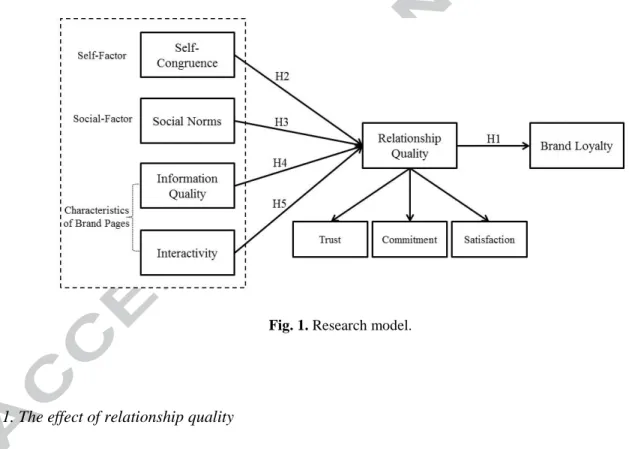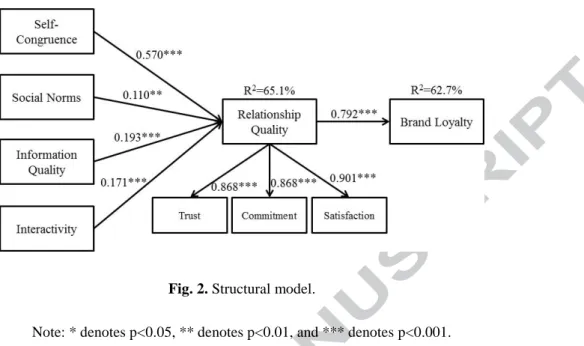To address this, we use the relationship quality perspective to suggest that brand loyalty is. In this research, our goal is to understand the determinants of brand loyalty while consumers follow companies' brand pages on social networking sites. First, it contributes to recent research on social commerce by examining brand loyalty on social networking sites.
For example, Casaló et al a, 2010b) explained the impact of consumer community participation on brand loyalty. This suggests that prior research on traditional online communities may not be sufficient to understand how to build consumer brand loyalty through corporate brand pages on social networking sites. Relationship quality is commonly conceptualized in the literature as a multidimensional construct (Liang et al., 2011; Smith, 1998).
This implies that companies can leverage the influences of self and social factors and the characteristics of brand pages to build brand loyalty on social networking sites. We argue that the quality of relationships can positively influence consumer brand loyalty on social networking sites. We argue that consumer self-congruence (the self factor) can have a positive effect on brand loyalty.
For example, self-congruence has been shown to influence consumers' product (Malhotra, 1988) and brand (Hong and Zinkhan, 1995) preferences and brand loyalty (Kressmann et al., 2006).

Research method
To ensure the quality of the responses, we asked each respondent a screening question to check if he/she had followed a brand page. We also asked for the name of the brand page that the respondent followed most often. Samsung, Lenovo, Apple and NBA were some of the most followed brands by the respondents.
A majority of respondents (76.2%) owned products by the brands they followed on the microblogging site. The demographic characteristics of our sample were consistent with the results of a recent survey by Weibo.com (Sina, 2013). Only minor modifications were made to the measures to ensure they have face validity in the current research context.
Ha and Im, 2012) Social Norms (SN) SN1: Most people who are important to me think I should follow the brand side. SN3: My close friends and family members think it's a good idea for me to follow the brand page. IN3: often responds in a timely manner to inquiries or comments from his followers on the brand page.
Data analysis and results
Second, we tested discriminant validity to ensure that items for different constructs have low cross-loadings because they are conceptually distinct. It is considered acceptable if the square root of the AVE for each construct is greater than any of its correlations with other constructs (Fornell and Larcker, 1981). Before estimating the structural model, we tested potential concerns about common method bias and multicollinearity. 2003), we performed Harman's one-factor test and the result showed that no single factor was eliminated and that none of the factors accounted for the majority of the variance.
The variance of each item was then explained by the main construct and the method factor. Our results showed that the mean variance explained by the main constructs was 80.8%, while the mean variance explained by the method factor was only 1.7%. We then followed the approach of Mason and Perreault (1991) and examined the multicollinearity of the independent variables.
The results indicated that the variance inflation factors (VIF) ranged from 1.330 to 3.322, which was well below the threshold of 10. In the structural model, we examined the coefficients and the explanatory power of the constructs. As shown in Figure 2, relationship quality (β=0.792, p<0.001) showed a significant impact on brand loyalty; thus, H1 was supported.
2 In the existing literature, relationship quality has been operationalized either as a second-order factor or directly with its dimensions. In this study, we operationalized it as a second-order factor for parsimony and better conceptual illustration. Nevertheless, we also tested the structural model using the first-order factors: trust, commitment and satisfaction.
The results showed that the four antecedents significantly influenced the three dimensions of relationship quality, which further influenced brand loyalty. As a post-hoc analysis, we examined the mediating role of relationship quality in the research model following the procedure suggested by Baron and Kenny (1986). As shown in Table 5 , relationship quality (RQ) fully mediated the effects of self-congruence (SC), social norms (SN), and interactivity (IN) on brand loyalty (BL).

Discussion and conclusion
Thus, it would be theoretically important and practically timely to consider whether companies can successfully apply these technologies to build brand loyalty. Second, to understand the building of brand loyalty in social commerce, we draw on the relationship quality perspective. Thus, we expect this study to extend previous research on building brand loyalty in such contexts.
We empirically demonstrate that the quality of consumers' relationship with a brand is a salient determinant of brand loyalty in companies. Third, this study proposes three categories of factors (i.e., the self factor, the social factor, and the characteristics of company brand pages) as key antecedents of relationship quality. We provide strong empirical evidence to show that companies can build brand loyalty by creating brand pages on social networking sites.
Otherwise, a brand page with poor information quality or a low level of interactivity is less likely to attract consumers, and certainly not enough to build consumer relationships and brand loyalty. In this regard, future research could include more factors (e.g. reputation and size of companies' brand social networks) in the research model in order to enrich our understanding of brand loyalty building in social commerce. In addition, some scholars claim that consumers' brand loyalty may develop differently between Western and Eastern cultures (S. S. Zhang et al., 2014).
In this study, we aim to understand the determinants of brand loyalty in the context of social business. We find that the effects of self-congruity, social norms, information quality, and interactivity are mediated by relationship quality, which further increases consumer brand loyalty. We believe this research provides a preliminary and empirical understanding of brand loyalty building in social business.
Relationship Quality, Community Promotion, and Brand Loyalty in Virtual Communities: Evidence from Free Software Communities. The chain of effects from brand trust and brand affect to brand performance: The role of brand loyalty. Relationships among community interaction characteristics, perceived benefits, community engagement, and adversarial brand loyalty in online brand communities.
To be or not to be on social media: How brand loyalty is affected by social media. The effects of social media-based brand communities on brand community markers, value creation practices, brand trust, and brand loyalty.